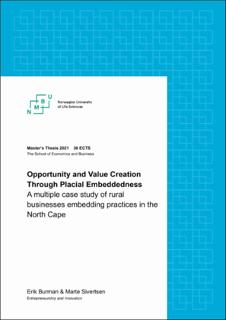| dc.description.abstract | This study aims to research how placial embeddedness can enable opportunities and value creation for businesses operating in a rural area. The thesis highlights the importance of adopting a spatial context when studying rural entrepreneurial processes using embeddedness theory. The qualitative multiple case study includes rural businesses within the fishery and tourism industry located in the North Cape, Norway. Considering the various enabling and restricting factors that come with being located on the northernmost point of Europe's mainland, this study contributes to understanding how the rural businesses experience that the spatial context affects their business. Additionally, we are interested in exploring how rural businesses utilise different embedding practices to become plaically embedded. Resulting in our overarching research question, which is:
How do rural businesses create opportunities and value through placial embeddedness?
Our research found that rural businesses created opportunities and value through three different embedding practices. Namely, Build strong ends-means relationships with local resource holders, Find new or use traditional ways of combining local resources, and Show concern for the well-being of the place. By considering the three practices in relation to each other, we discovered a reinforcing embedding process. By becoming more placially embedded, the rural businesses were able to form new relationships with relevant resource holders, which led to the businesses gaining a more intimate knowledge of the resources in the place. Next, the rural businesses were able to use these relationships and knowledge to create new products or services that ensured value for the business. Finally, we discovered that by becoming placially embedded, the businesses also gained a greater sense of belonging that ultimately led the businesses to care for the well-being of the place. However, we also discovered that both the enabling and restricting contextual factors of the place influenced the businesses. Especially the choice of embedding practices was affected by the restricting contextual factors. Consequently, if the restricting context hindered the forming of new relationships between actors locally, the businesses were more likely to engage in bridging practices in a broader spatial context. | en_US |

